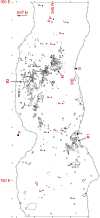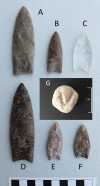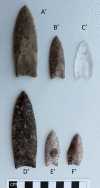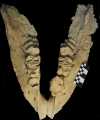Human (Clovis)-gomphothere (Cuvieronius sp.) association ∼ 13,390 calibrated yBP in Sonora, Mexico
- PMID:25024193
- PMCID: PMC4121807
- DOI: 10.1073/pnas.1404546111
Human (Clovis)-gomphothere (Cuvieronius sp.) association ∼ 13,390 calibrated yBP in Sonora, Mexico
Abstract
The earliest known foragers to populate most of North America south of the glaciers [∼ 11,500 to ≥ ∼ 10,800 (14)C yBP; ∼ 13,300 to ∼ 12,800 calibrated (Cal) years] made distinctive "Clovis" artifacts. They are stereotypically characterized as hunters of Pleistocene megamammals (mostly mammoth) who entered the continent via Beringia and an ice-free corridor in Canada. The origins of Clovis technology are unclear, however, with no obvious evidence of a predecessor to the north. Here we present evidence for Clovis hunting and habitation ∼ 11,550 yBP (∼ 13,390 Cal years) at "El Fin del Mundo," an archaeological site in Sonora, northwestern Mexico. The site also includes the first evidence to our knowledge for gomphothere (Cuvieronius sp.) as Clovis prey, otherwise unknown in the North American archaeological record and terminal Pleistocene paleontological record. These data (i) broaden the age and geographic range for Clovis, establishing El Fin del Mundo as one of the oldest and southernmost in situ Clovis sites, supporting the hypothesis that Clovis had its origins well south of the gateways into the continent, and (ii) expand the make-up of the North American megafauna community just before extinction.
Keywords: Paleoindian; proboscidean.
Conflict of interest statement
The authors declare no conflict of interest.
Figures






Comment in
- Clovis at the end of the world.Meltzer DJ.Meltzer DJ.Proc Natl Acad Sci U S A. 2014 Aug 26;111(34):12276-7. doi: 10.1073/pnas.1412945111. Epub 2014 Aug 13.Proc Natl Acad Sci U S A. 2014.PMID:25122674Free PMC article.No abstract available.
References
- Waters MR, Stafford TW., Jr Redefining the age of Clovis: Implications for the peopling of the Americas. Science. 2007;315(5815):1122–1126. - PubMed
- Haynes G, et al. Comment on “Redefining the age of Clovis: Implications for the peopling of the Americas”. Science. 2007;317(5836):320, author reply 320. - PubMed
- Haynes G. The Early Settlement of North America: The Clovis Era. New York: Cambridge Univ Press; 2002.
- Jennings TA, Waters MR. Pre-Clovis lithic technology at the Debra L. Friedkin site, Texas: Comparisons to Clovis through site-level behavior, technological trait-list, and cladistics analysis. Am Antiq. 2014;79:25–44.
- Buchanan B, Collard M. Phenetics, cladistics, and the search for the Alaskan ancestors of the Paleoindians: A reassessment of relationships among the Clovis, Nenana, and Denali archaeological complexes. J Arch Sci. 2009;35:1683–1694.
Publication types
MeSH terms
LinkOut - more resources
Full Text Sources
Other Literature Sources
Molecular Biology Databases
